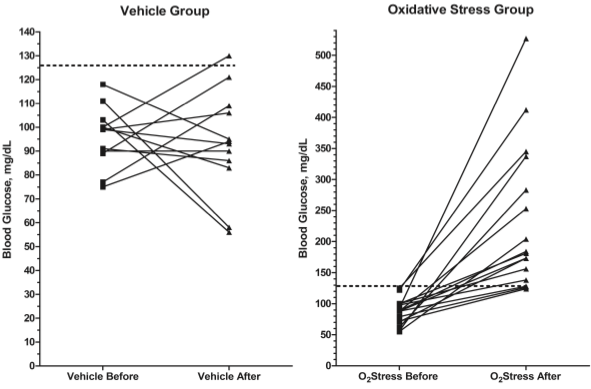From Discussions VOL. 5 NO. 2Proxidant Injection Causes the Onset of Type 2 Diabetes in the Spontaneously Hypertensive Obese (SHROB/Kol) RatMethodsSHROB rats were obtained from Charles River at 10 weeks of age. Body weight and food intake were monitored 3 days per week throughout the study. Rats were administered inter-peritoneal injections for 7 days, were allowed to recover for 3 days, and then injected for 3 more days prior to oral glucose tolerance testing with either a proxidant solution or saline. Six rats received a proxidant solution of 50 mg/kg doses of both L-buthionine sulfoximine and hydroquinone. Six rats received saline injections. Tail blood was obtained under local anesthesia and tested for glucose using a meter and test strips (One-Touch Ultra). Blood samples were centrifuged and plasma was frozen immediately for later analysis. Oral glucose tolerance testing was conducted after the final day of injections. Rats were fasted 18h then gavaged with a 50% glucose solution at a dose of 6 g/kg. Rats were then injected with either saline or proxidant solution. Tail blood was obtained under local anesthesia at 0, 30, 60, 120, and 360 minutes after glucose loading. Rat sacrifice with organ harvest occurred within 5 days of oral glucose tolerance testing. Peroxides were measured as a marker of oxidative stress in plasma samples using the ferric orange xylenol (FOX) method (Sigma Chemicals; Peroxi-Detect kit). ResultsProxidant injection of L-buthionine sulfoximine and hydroquinone was found to increase blood glucose levels significantly over five days of injections (injected group baseline 87±5 to 234±29 mg/dL on day 5 versus vehicle group baseline 96±4 to 93±6 mg/dL on day 5; see Figure 3 on right). Figure 3: Morning blood glucose levels at the beginning of the study were all well below 126 mg/dL in both groups of SHROB (labeled Vehicle Before and O2Stress Before). Glucose levels remained relatively constant and below 126 mg/dL in SHROB receiving vehicle saline injection for 5 days (labeled Vehicle After). In contrast, SHROB subjected to oxidative stress through 5 days of proxidant injections showed marked hyperglycemia, with all but 3 of the 17 rats showing diabetic blood glucose levels above 126 mg/dL.
By the second day of proxidant injection, morning glucose rose significantly above 124 mg/dL, the threshold for diagnosing diabetes. Glucose levels remained elevated for the duration of injection and fell within 3 days upon cessation of injection. However, a re-initiation of proxidant injection in the days leading up to oral glucose tolerance testing resulted in an elevation of blood glucose levels. Control SHROB receiving saline solution remained in the pre-diabetic range (100-125 mg/dL glucose) throughout the course of injections. Glucose tolerance was found to be impaired in proxidant treated SHROB relative to those receiving saline injection. Following 7 consecutive days of injections, glucose tolerance was measured and found to be impaired in proxidant treated SHROB relative to those receiving saline injection. Oxidative stress significantly increased glucose overall, with blood glucose levels remaining in the diabetic range 360 minutes after glucose challenge. However, upon re-initiation of injections for an additional 3 days following a 3 day recovery period, an oral glucose tolerance test found even greater impairment of glucose tolerance in proxidant treated SHROB relative to those receiving saline injection. Body weight monitored continuously throughout the study found there to be no change in body weight during proxidant injections as compared to rats receiving control injections. Treatment groups did not differ in body weight by 2-way analysis of variance with repeated measures. Oxidative stress was measured by assay of peroxides in plasma and the liver fraction of kidney and liver tissue. Proxidant injection increased plasma peroxide levels within 1h with a return to baseline levels within 24h . Baseline plasma peroxide levels were found to be 20±2 μmol/L, with elevation to 43±8 μmol/L at 1h, followed by a subsequent decrease to 31±6 μmol/L at 4h and 17±1 μmol/L at 24h.Continued on Next Page » Suggested Reading from Inquiries Journal
Inquiries Journal provides undergraduate and graduate students around the world a platform for the wide dissemination of academic work over a range of core disciplines. Representing the work of students from hundreds of institutions around the globe, Inquiries Journal's large database of academic articles is completely free. Learn more | Blog | Submit Latest in Health Science |




















